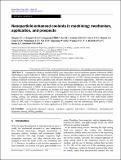Nanoparticle-enhanced coolants in machining: mechanism, application, and prospects
Author(s)
Hu, Shuguo; Li, Changhe; Zhou, Zongming; Liu, Bo; Zhang, Yanbin; Yang, Min; Li, Benkai; Gao, Teng; Liu, Mingzheng; Cui, Xin; Wang, Xiaoming; Xu, Wenhao; Dambatta, Y. S.; Li, Runze; Sharma, Shubham; ... Show more Show less
Download11465_2023_Article_769.pdf (7.080Mb)
Publisher with Creative Commons License
Publisher with Creative Commons License
Creative Commons Attribution
Terms of use
Metadata
Show full item recordAbstract
Nanoparticle-enhanced coolants (NPECs) are increasingly used in minimum quantity lubrication (MQL) machining as a green lubricant to replace conventional cutting fluids to meet the urgent need for carbon emissions and achieve sustainable manufacturing. However, the thermophysical properties of NPEC during processing remain unclear, making it difficult to provide precise guidance and selection principles for industrial applications. Therefore, this paper reviews the action mechanism, processing properties, and future development directions of NPEC. First, the laws of influence of nano-enhanced phases and base fluids on the processing performance are revealed, and the dispersion stabilization mechanism of NPEC in the preparation process is elaborated. Then, the unique molecular structure and physical properties of NPECs are combined to elucidate their unique mechanisms of heat transfer, penetration, and antifriction effects. Furthermore, the effect of NPECs is investigated on the basis of their excellent lubricating and cooling properties by comprehensively and quantitatively evaluating the material removal characteristics during machining in turning, milling, and grinding applications. Results showed that turning of Ti–6Al–4V with multi-walled carbon nanotube NPECs with a volume fraction of 0.2% resulted in a 34% reduction in tool wear, an average decrease in cutting force of 28%, and a 7% decrease in surface roughness Ra, compared with the conventional flood process. Finally, research gaps and future directions for further applications of NPECs in the industry are presented.
Date issued
2024-01-02Department
Massachusetts Institute of Technology. Department of Mechanical EngineeringPublisher
Higher Education Press
Citation
Frontiers of Mechanical Engineering. 2024 Jan 02;18(4):53
Version: Final published version